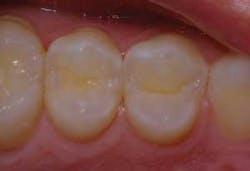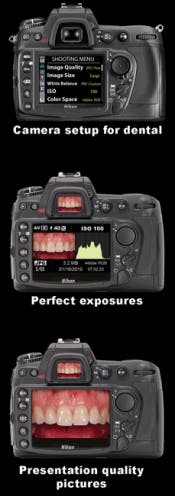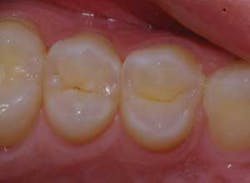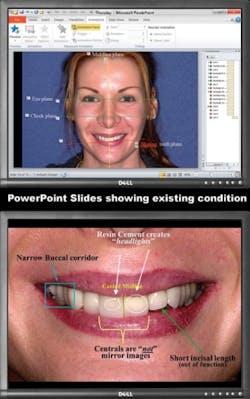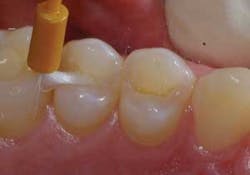Imaging in dentistry
by Gregory M. Lutke, DDS
Over the past decade, digital imaging in dentistry has come to describe several technologies. This article will focus on digital images captured by digital cameras and their use in patient consultations.
Although digital photography is no longer new, the power of high-quality photography is still “king” of dental technologies with regard to patient communication. The opportunity to communicate directly and visually with our patients empowers the Big 3 in dentistry:
1. Diagnosis (disease, trauma, or esthetic dilemma)
2. Treatment planning (multidisciplinary or sequence)
3. The treatment preview (accurate cosmetic imaging of the proposed result)
Cosmetic or esthetic dentistry has become mainstream in general dentistry, with patient demand increasing yearly. If the goal of cosmetic dentistry is completely visual, then our consultation should also be completely visual. I call this visual experience the Digital Patient Consultation (DPC).
The opportunity
As dentists, we have the opportunity to communicate visually with our patients. Fully informed and educated patients proactively accept fully optimized treatment plans in both function and esthetics, which is their goal. The DPC is the path for making this goal a reality. Historically, dental consultants have taught dentists and their staffs to use verbal skills to communicate their cases. This approach leads to a certain level of success, especially in non-appearance-related dental treatment. But the reality is, in our modern society patients are focused on esthetics.
Studies have universally demonstrated that people learn most efficiently visually. The DPC is completely visual, exactly like the treatment we provide our patients. Clear and accurate digital photography presented visually is the whole premise.
A completely customized presentation that describes a particular dental condition with accurate imaging of optimum treatment is the communication patients need for case acceptance. With words we can communicate only so much, but visually and through the eyes of our patients, we can communicate results. In our present economy with perhaps fewer discretionary funds, our patients are even more results-focused.
Give them an accurate result based on the wonderful advancements in modern dentistry, and they will commit their funds, time, and energy to achieve that result. They say a picture is worth a thousand words; the DPC helps you communicate visually with your patients.
One critical step along the path is mastering the digital technology user skills. The nonclinical skills necessary for a digital patient consultation are new to most dental professionals, because they are not taught in dental schools. Communication skills must be mastered to effectively illustrate our clinical expertise. Our patients just need a way to see our abilities. Here are the new skills:
• Capturing images of patients with an SLR digital camera.
• Making certain the digital images are completely color-accurate, properly exposed, and cropped for simple visual understanding. The high-quality pictures should replicate the patient’s present condition clearly.
• Presenting the optimum treatment plan with digital photographs, digital X-rays, digital video, and cosmetic imaging of the proposed treatment plan.
The development of camera and computer user skills is primary. Remember, the presentation is composed of stunning digital photography. The quality of the images is due to human user skills and far less from the camera hardware. In the past, dental professionals focused on buying the correct hardware and software. The DPC is a clear departure from this old model. It is a technical skill ... based on people skills. These technical skills are learned just once, yet they pay off in practice-transforming results forever. My experience with dental professionals has demonstrated that once they master digital computer technology, they have the skills to stay current even as the technology continues to advance.
I recommend Adobe Photoshop for all dental professionals. Photoshop is really a suite of software that downloads, catalogues, and applies crops and exposure corrections. These edits result in incredible image quality. Photoshop also has several slideshow options for your consultations. These slideshow options offer the simplest solution for 80% of my cases.
The other software I recommend is Microsoft PowerPoint, which I really enjoy using on complex cases. PowerPoint is a simple software that allows you to include X-rays, digital video, and cosmetic imaging, with impressive “morphs” using a before and proposed after image in your consultations.
Adobe Photoshop is used for all cosmetic imaging to create the new proposed smile for the DPC. The work in Photoshop always precedes the creation of the presentation in PowerPoint.
The skills needed for Adobe Photoshop are straightforward. Any dental professional can learn how to effectively use the software on a daily basis. Simply put, I believe cosmetic imaging is the single most powerful aspect of my consultations. Cosmetic imaging is the deal-closer! We must strive to upgrade our computer user skills to the level of our dentistry. Excellence is mandatory for results.
The presentation
In the process of preparing our presentation, we study all of the high-quality digital images of the patient. We believe this is the major component of the diagnostic process. Sometimes we see the complete treatment answer for the first time in the privacy of preparation.
This study of the patient images shows us the result just like it will be shown to our patients. Once dental professionals learn to prepare visually with all the patient images, the resulting treatment plans will become optimized in all treatment phases ... and with a clear end in mind for both dentist and patient.
Most presentations have between 10 and 20 slides. The consultation begins with a systematic walk-through of your patient’s existing condition. Before we can offer any treatment suggestions, we must fully communicate the clinical findings with high-quality pictures and all necessary X-rays. Digital video is also quite helpful in demonstrating lip line or tissue problems. Once our patients fully understand their current situation, only then do we move forward to presenting treatment solutions.
In a visual consultation, the most important solution picture is the proposed new smile. Cosmetic imaging is the final picture in the DPC. Every effort should be made to present an accurate result of treatment — in both esthetics and function.
Cosmetic imaging is so powerful that total honesty and ethics are paramount with this technology. I would strongly suggest that you attempt to show exactly the result you can deliver with your treatment sequence. If this sequence involves a specialist, then request his or her input on the cosmetic imaging as well.
The result
The truest celebration of our cases is portrait photography — the beautiful pictures of our patients after their cases are complete. Portrait photography is a joyful collection of successful cases and happy patients.
Patients who are crystal clear on their treatment results will pursue their treatment recommendations.
Simply put, the quality of your patient acceptance will equal the quality of your visual communication.
Understanding the premise of the Digital Patient Consultation occurs in just a moment. The path to learning user skills requires several months. The results will transform your dental practice as you concentrate on your patients instead of the business of “selling dentistry.” Congratulations in advance — your digital success will change everything!
Gregory M. Lutke, DDS, is in full-time private practice in Plano, Texas, specializing in esthetic zone dentistry. As founder of Dallas Dental Solutions, a digital hands-on facility, Dr. Lutke teaches advanced hands-on courses on digital dentistry communication technology, focusing on the digital photography, Adobe Photoshop, Microsoft PowerPoint, and digital video. Visit www.dental-solutions.com or call (972) 378-4141 for more information.
For more on this topic, go to www.dentaleconomics.com and search using the following key words: imaging, digital imaging, digital photography, cosmetic dentistry, Dr. Greg Lutke.


